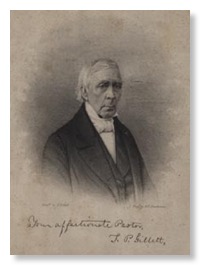 This church and the town of Branford were settled by Puritans from Wethersfield and New Haven in 1644.
This church and the town of Branford were settled by Puritans from Wethersfield and New Haven in 1644.
The first Meetinghouse, built of logs with a thatched roof and dirt floor, was erected near the river, in what is now Center Cemetery. The church's first minister was John Sherman, whose relative Roger Sherman was the first mayor of New Haven and the signer of every document proclaiming and attesting to the independence of the colonies. The first "settled" minister was Abraham Pierson, who guided the church and town for twenty years. A strict Congregationalist and Puritan, Mr. Pierson refused to accept the annexation of the New Haven Colony by the Connecticut Colony where persons other than Congregationalists (if they were of good character and owned an estate of more than thirty pounds!) could vote.
When the annexation became law, by royal decree and charter, Mr. Pierson and a majority of Branford residents emigrated to New Jersey in 1667 to found the village of Newark, where "None shall be admitted as free men or burgesses, but such planters as are members of some or others of the Congregational Churches. Nor shall any but such be chosen to magistracy...or to have power to vote in establishing laws...though all others admitted...do and shall enjoy all other civil liberties and privileges."
In 1687 the church was reorganized and Rev. Samuel Russel began his forty-four year pastorate here. The Covenant, which is still used as the basis for church membership today, was prepared.
In 1699 John Taintor bequeathed to the church/town his home plot of land, and a new church was erected in the center of the Green, approximately in front of the present Town Hall. A table from Rev . Russel's home, purportedly used by the area ministers while founding the Collegiate School which would become Yale College in 1701, is used in the Meetinghouse today as the communion table.
Philemon Robbins, who started his ministry in 1732, defended the liberty of the local minister and church, rather than honoring the authority of the "Consociation of Churches" in governing its own affairs.
The first Meetinghouse on the Green (the second church building) was razed and a new one built almost in the present location, but facing South Main Street, in 1741. That structure was taken down and the present (fourth) church was constructed in 1843 at a cost of $9,000. Originally it was of Greek Revival style with fluted pillars, a wide verandah and a center steeple.
In 1722, a "daughter" church was organized in North Farms, now North Branford, and in 1750 a "grand-daughter" church was organized in Northford. Also in 1750 the "professors of the Church of England" asked to gather in the Meetinghouse on December 25 to celebrate what they called Christmas; the Congregational Church did not celebrate Christmas at that time. Thirty-four years later, in 1784, Trinity Episcopal Church (The First Episcopal Society) was founded; a large number of Branford Congregationalists, who disliked the choice of Rev. Jason Atwater as their new minister, were included in the congregation.
"Father" Timothy Gillett began a 58 year pastorate in 1807, during which time he organized the Sunday School and later (about 1820) the Academy, a "Select School", where he was the teacher for almost 20 years.
In 1867 the Indian Neck land, purchased from Native Americans by the First Ecclesiastical Society over the preceding 200 years, was leased to a church member for $900/year for 99 years; the lessee then sub-let the land to individuals. The following year (1868) the Meetinghouse was enlarged and the present facade and steeple erected. The church was remodeled in 1946, installing the divided chancel, and nine years later the educational wing was added, paid for by the sale of the Indian Neck property. In 1997 the wooden steeple and cupola were replaced with aluminum replicas and an electric clock and bell-striking mechanism were installed to replace the old (circa 1800) mechanism. The New Wing was dedicated in the year 2000...testimony to our faith in the future of our church.
The following year (1868) the Meetinghouse was enlarged and the present facade and steeple erected. The church was remodeled in 1946, installing the divided chancel, and nine years later the educational wing was added, paid for by the sale of the Indian Neck property. In 1997 the wooden steeple and cupola were replaced with aluminum replicas and an electric clock and bell-striking mechanism were installed to replace the old (circa 1800) mechanism. The New Wing was dedicated in the year 2000...testimony to our faith in the future of our church.
May this church of God and Jesus Christ continue to follow where the Spirit leads it in the future.
Many thanks to David Driessens, who authored the text for this page, and loaned valuable archival material. Photos are from "A History of The First Church and Society of Branford,Connecticut," J. Rupert Simonds.